Business Strategy Report: Analyzing Aldi's Strategic Planning in UK
VerifiedAdded on 2020/06/03
|17
|5000
|71
Report
AI Summary
This report provides a comprehensive analysis of Aldi's business strategy. It begins by outlining Aldi's mission, vision, objectives, goals, and core competencies, followed by a discussion of the factors influencing strategic planning. The report evaluates strategic planning techniques like the BCG matrix and SPACE matrix, and also includes SWOT, PESTLE, and Porter's Five Forces analyses. It further explores the appropriateness of alternative strategies for Aldi, considering substantive, limited growth, and retrenchment options. Task 2 focuses on stakeholder analysis and the development of a new strategy using Mendelow's matrix. The report concludes with an examination of the roles, responsibilities, and resource requirements for strategy implementation, including the use of SMART targets. The report analyzes Aldi's competitive position in the UK grocery market, and its approach to achieving sustainable growth.
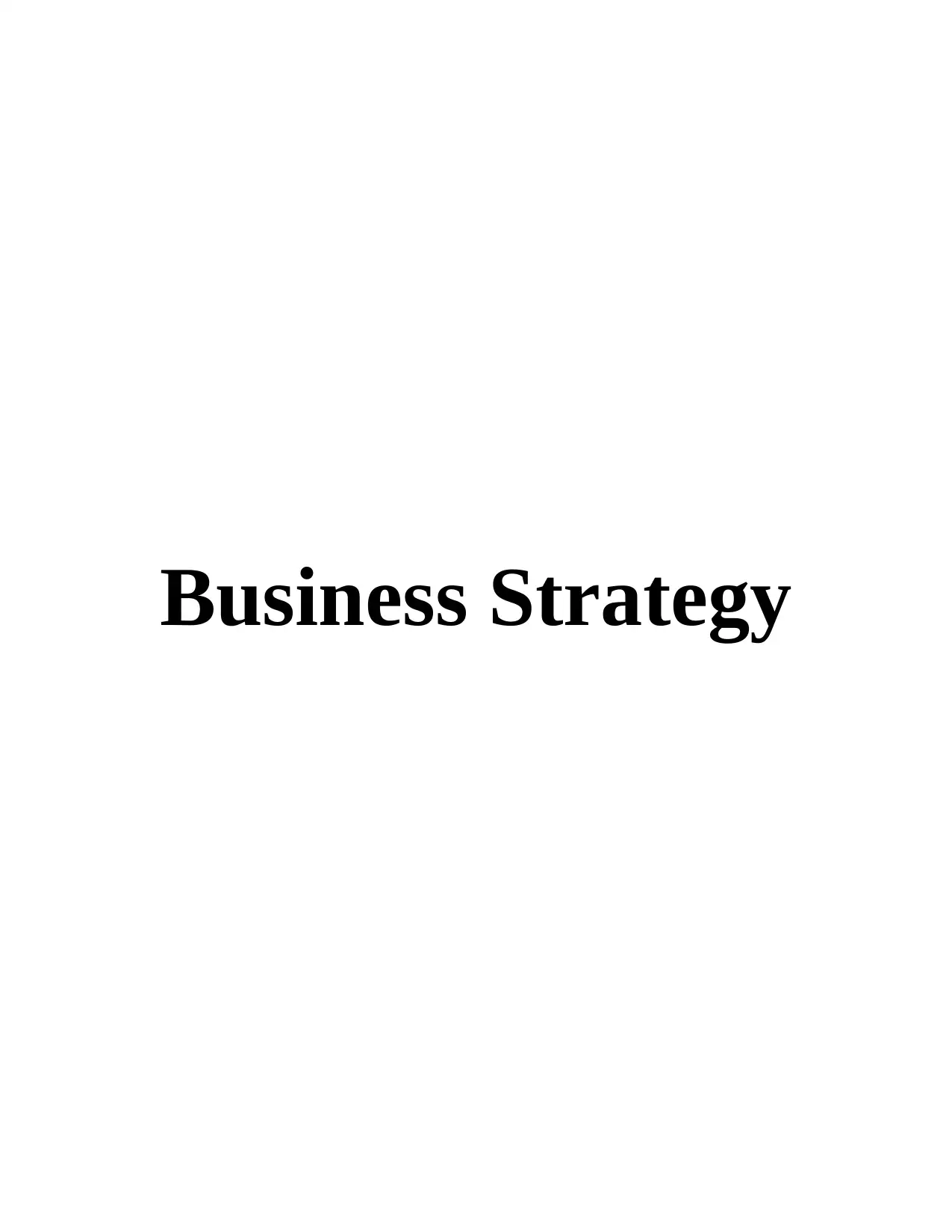
Business Strategy
Paraphrase This Document
Need a fresh take? Get an instant paraphrase of this document with our AI Paraphraser
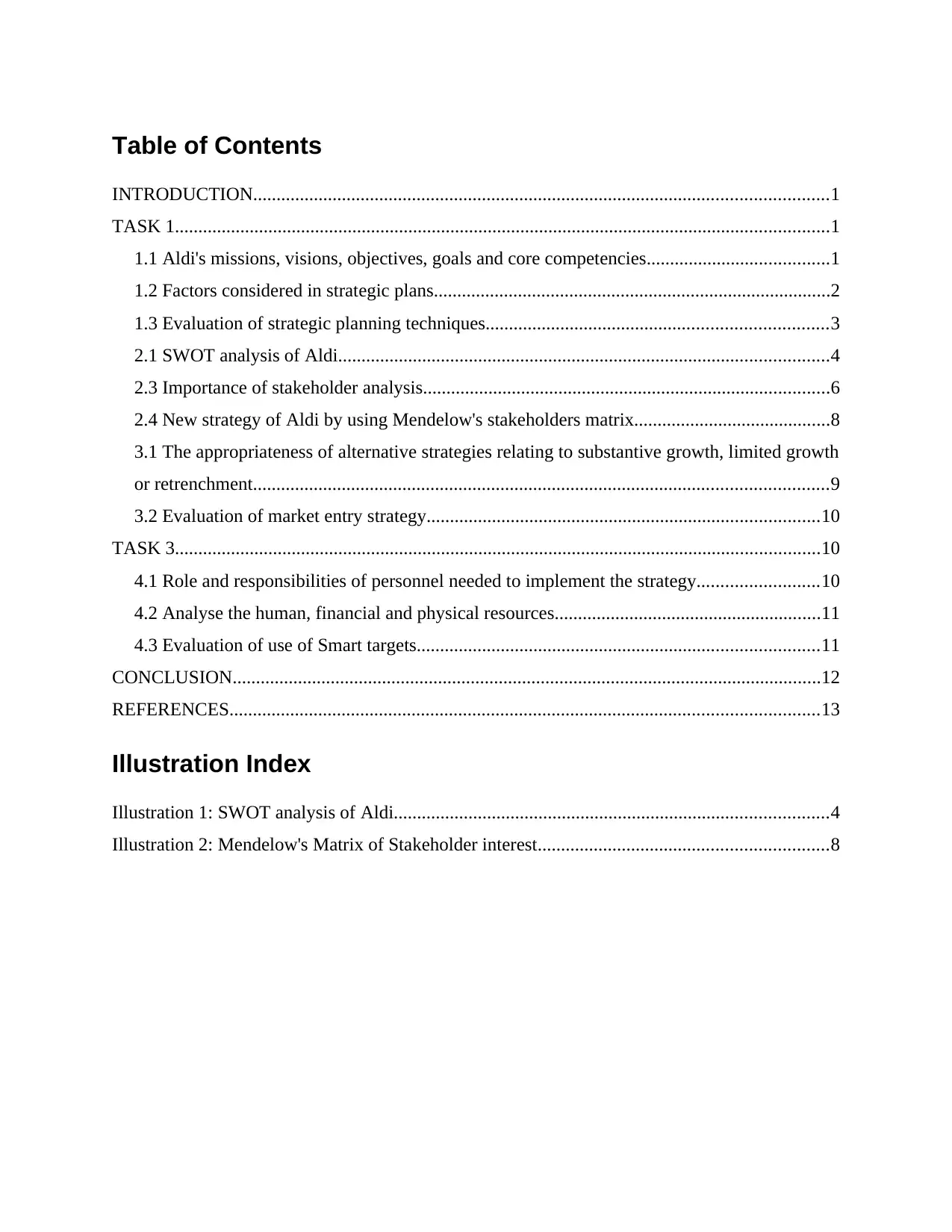
Table of Contents
INTRODUCTION...........................................................................................................................1
TASK 1............................................................................................................................................1
1.1 Aldi's missions, visions, objectives, goals and core competencies.......................................1
1.2 Factors considered in strategic plans.....................................................................................2
1.3 Evaluation of strategic planning techniques.........................................................................3
2.1 SWOT analysis of Aldi.........................................................................................................4
2.3 Importance of stakeholder analysis.......................................................................................6
2.4 New strategy of Aldi by using Mendelow's stakeholders matrix..........................................8
3.1 The appropriateness of alternative strategies relating to substantive growth, limited growth
or retrenchment...........................................................................................................................9
3.2 Evaluation of market entry strategy....................................................................................10
TASK 3..........................................................................................................................................10
4.1 Role and responsibilities of personnel needed to implement the strategy..........................10
4.2 Analyse the human, financial and physical resources.........................................................11
4.3 Evaluation of use of Smart targets......................................................................................11
CONCLUSION..............................................................................................................................12
REFERENCES..............................................................................................................................13
Illustration Index
Illustration 1: SWOT analysis of Aldi.............................................................................................4
Illustration 2: Mendelow's Matrix of Stakeholder interest..............................................................8
INTRODUCTION...........................................................................................................................1
TASK 1............................................................................................................................................1
1.1 Aldi's missions, visions, objectives, goals and core competencies.......................................1
1.2 Factors considered in strategic plans.....................................................................................2
1.3 Evaluation of strategic planning techniques.........................................................................3
2.1 SWOT analysis of Aldi.........................................................................................................4
2.3 Importance of stakeholder analysis.......................................................................................6
2.4 New strategy of Aldi by using Mendelow's stakeholders matrix..........................................8
3.1 The appropriateness of alternative strategies relating to substantive growth, limited growth
or retrenchment...........................................................................................................................9
3.2 Evaluation of market entry strategy....................................................................................10
TASK 3..........................................................................................................................................10
4.1 Role and responsibilities of personnel needed to implement the strategy..........................10
4.2 Analyse the human, financial and physical resources.........................................................11
4.3 Evaluation of use of Smart targets......................................................................................11
CONCLUSION..............................................................................................................................12
REFERENCES..............................................................................................................................13
Illustration Index
Illustration 1: SWOT analysis of Aldi.............................................................................................4
Illustration 2: Mendelow's Matrix of Stakeholder interest..............................................................8
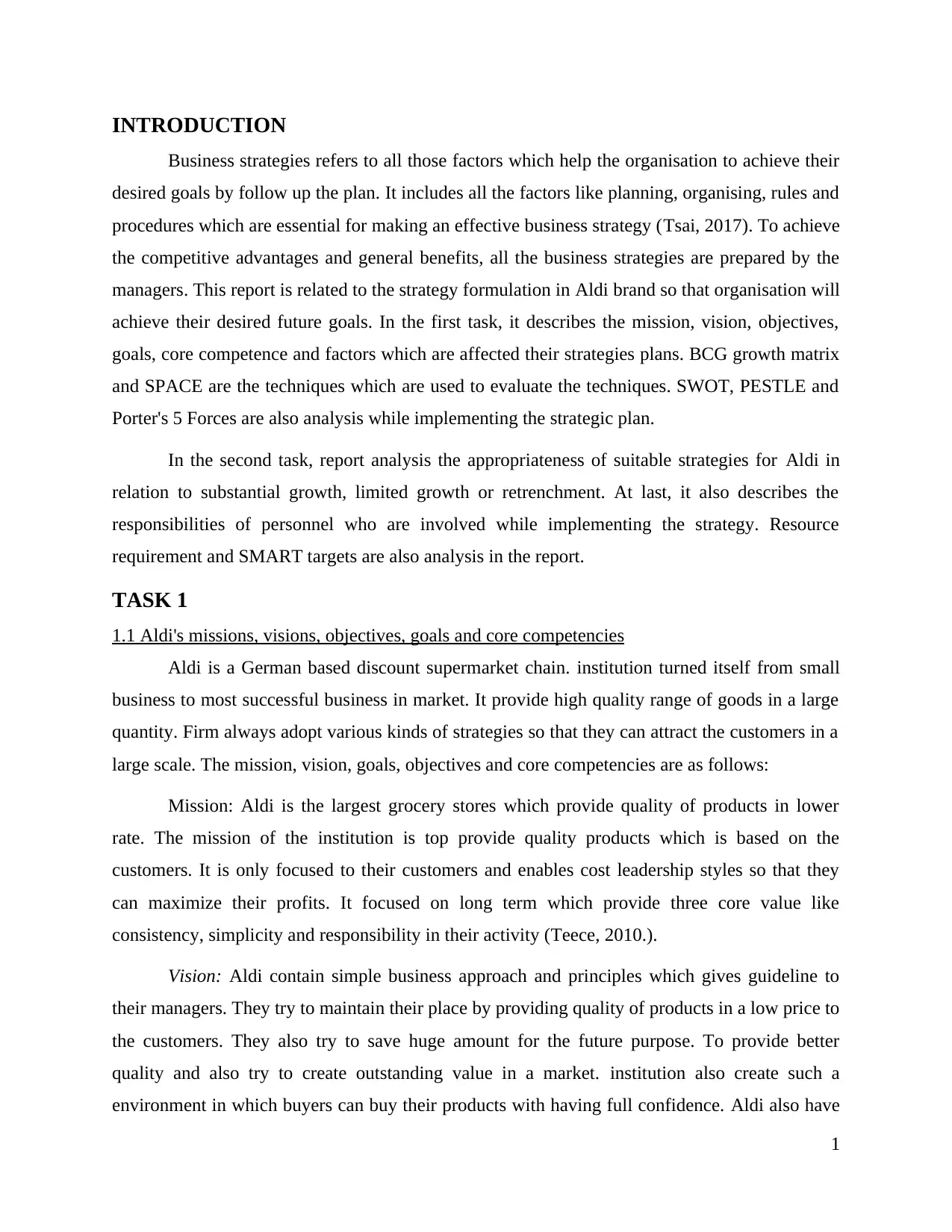
INTRODUCTION
Business strategies refers to all those factors which help the organisation to achieve their
desired goals by follow up the plan. It includes all the factors like planning, organising, rules and
procedures which are essential for making an effective business strategy (Tsai, 2017). To achieve
the competitive advantages and general benefits, all the business strategies are prepared by the
managers. This report is related to the strategy formulation in Aldi brand so that organisation will
achieve their desired future goals. In the first task, it describes the mission, vision, objectives,
goals, core competence and factors which are affected their strategies plans. BCG growth matrix
and SPACE are the techniques which are used to evaluate the techniques. SWOT, PESTLE and
Porter's 5 Forces are also analysis while implementing the strategic plan.
In the second task, report analysis the appropriateness of suitable strategies for Aldi in
relation to substantial growth, limited growth or retrenchment. At last, it also describes the
responsibilities of personnel who are involved while implementing the strategy. Resource
requirement and SMART targets are also analysis in the report.
TASK 1
1.1 Aldi's missions, visions, objectives, goals and core competencies
Aldi is a German based discount supermarket chain. institution turned itself from small
business to most successful business in market. It provide high quality range of goods in a large
quantity. Firm always adopt various kinds of strategies so that they can attract the customers in a
large scale. The mission, vision, goals, objectives and core competencies are as follows:
Mission: Aldi is the largest grocery stores which provide quality of products in lower
rate. The mission of the institution is top provide quality products which is based on the
customers. It is only focused to their customers and enables cost leadership styles so that they
can maximize their profits. It focused on long term which provide three core value like
consistency, simplicity and responsibility in their activity (Teece, 2010.).
Vision: Aldi contain simple business approach and principles which gives guideline to
their managers. They try to maintain their place by providing quality of products in a low price to
the customers. They also try to save huge amount for the future purpose. To provide better
quality and also try to create outstanding value in a market. institution also create such a
environment in which buyers can buy their products with having full confidence. Aldi also have
1
Business strategies refers to all those factors which help the organisation to achieve their
desired goals by follow up the plan. It includes all the factors like planning, organising, rules and
procedures which are essential for making an effective business strategy (Tsai, 2017). To achieve
the competitive advantages and general benefits, all the business strategies are prepared by the
managers. This report is related to the strategy formulation in Aldi brand so that organisation will
achieve their desired future goals. In the first task, it describes the mission, vision, objectives,
goals, core competence and factors which are affected their strategies plans. BCG growth matrix
and SPACE are the techniques which are used to evaluate the techniques. SWOT, PESTLE and
Porter's 5 Forces are also analysis while implementing the strategic plan.
In the second task, report analysis the appropriateness of suitable strategies for Aldi in
relation to substantial growth, limited growth or retrenchment. At last, it also describes the
responsibilities of personnel who are involved while implementing the strategy. Resource
requirement and SMART targets are also analysis in the report.
TASK 1
1.1 Aldi's missions, visions, objectives, goals and core competencies
Aldi is a German based discount supermarket chain. institution turned itself from small
business to most successful business in market. It provide high quality range of goods in a large
quantity. Firm always adopt various kinds of strategies so that they can attract the customers in a
large scale. The mission, vision, goals, objectives and core competencies are as follows:
Mission: Aldi is the largest grocery stores which provide quality of products in lower
rate. The mission of the institution is top provide quality products which is based on the
customers. It is only focused to their customers and enables cost leadership styles so that they
can maximize their profits. It focused on long term which provide three core value like
consistency, simplicity and responsibility in their activity (Teece, 2010.).
Vision: Aldi contain simple business approach and principles which gives guideline to
their managers. They try to maintain their place by providing quality of products in a low price to
the customers. They also try to save huge amount for the future purpose. To provide better
quality and also try to create outstanding value in a market. institution also create such a
environment in which buyers can buy their products with having full confidence. Aldi also have
1
⊘ This is a preview!⊘
Do you want full access?
Subscribe today to unlock all pages.

Trusted by 1+ million students worldwide
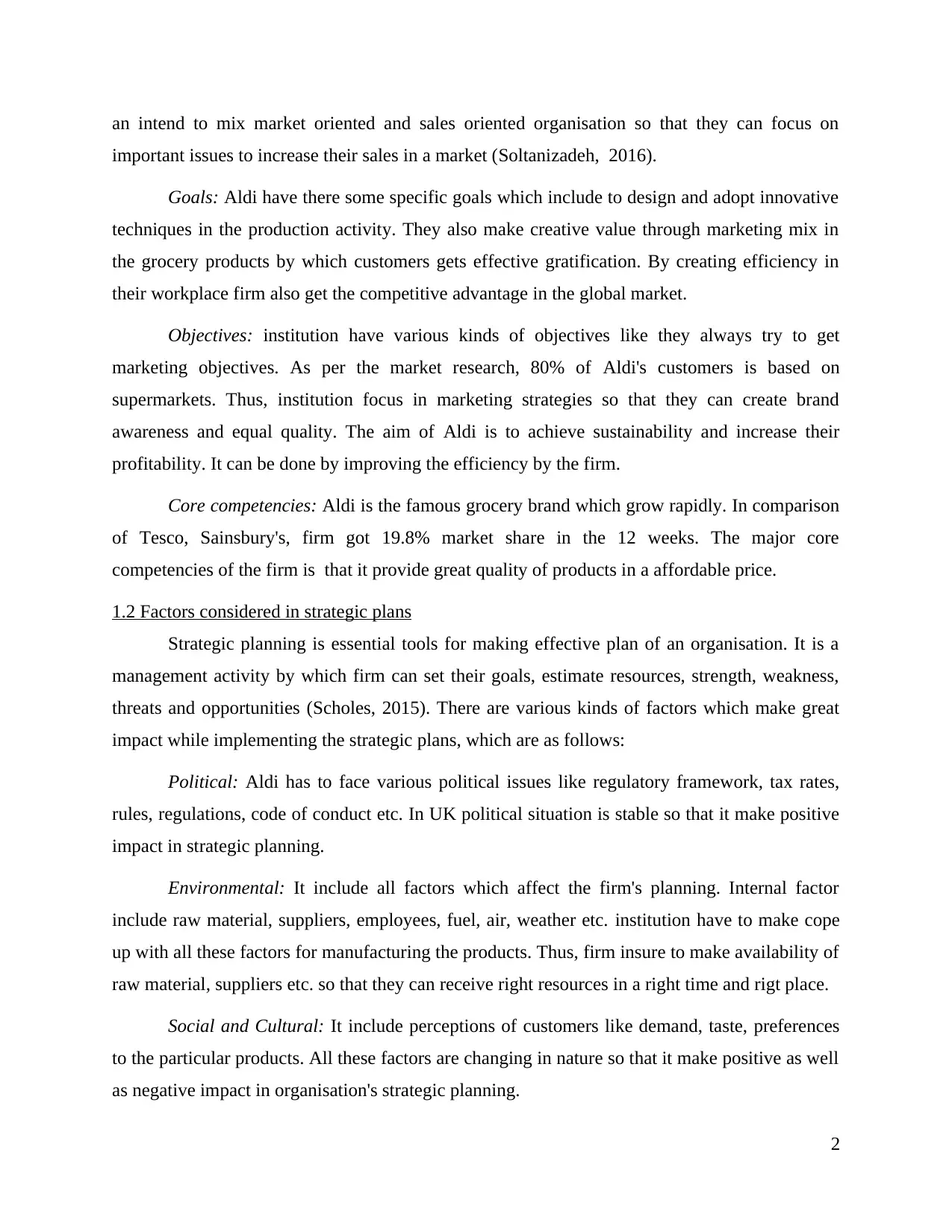
an intend to mix market oriented and sales oriented organisation so that they can focus on
important issues to increase their sales in a market (Soltanizadeh, 2016).
Goals: Aldi have there some specific goals which include to design and adopt innovative
techniques in the production activity. They also make creative value through marketing mix in
the grocery products by which customers gets effective gratification. By creating efficiency in
their workplace firm also get the competitive advantage in the global market.
Objectives: institution have various kinds of objectives like they always try to get
marketing objectives. As per the market research, 80% of Aldi's customers is based on
supermarkets. Thus, institution focus in marketing strategies so that they can create brand
awareness and equal quality. The aim of Aldi is to achieve sustainability and increase their
profitability. It can be done by improving the efficiency by the firm.
Core competencies: Aldi is the famous grocery brand which grow rapidly. In comparison
of Tesco, Sainsbury's, firm got 19.8% market share in the 12 weeks. The major core
competencies of the firm is that it provide great quality of products in a affordable price.
1.2 Factors considered in strategic plans
Strategic planning is essential tools for making effective plan of an organisation. It is a
management activity by which firm can set their goals, estimate resources, strength, weakness,
threats and opportunities (Scholes, 2015). There are various kinds of factors which make great
impact while implementing the strategic plans, which are as follows:
Political: Aldi has to face various political issues like regulatory framework, tax rates,
rules, regulations, code of conduct etc. In UK political situation is stable so that it make positive
impact in strategic planning.
Environmental: It include all factors which affect the firm's planning. Internal factor
include raw material, suppliers, employees, fuel, air, weather etc. institution have to make cope
up with all these factors for manufacturing the products. Thus, firm insure to make availability of
raw material, suppliers etc. so that they can receive right resources in a right time and rigt place.
Social and Cultural: It include perceptions of customers like demand, taste, preferences
to the particular products. All these factors are changing in nature so that it make positive as well
as negative impact in organisation's strategic planning.
2
important issues to increase their sales in a market (Soltanizadeh, 2016).
Goals: Aldi have there some specific goals which include to design and adopt innovative
techniques in the production activity. They also make creative value through marketing mix in
the grocery products by which customers gets effective gratification. By creating efficiency in
their workplace firm also get the competitive advantage in the global market.
Objectives: institution have various kinds of objectives like they always try to get
marketing objectives. As per the market research, 80% of Aldi's customers is based on
supermarkets. Thus, institution focus in marketing strategies so that they can create brand
awareness and equal quality. The aim of Aldi is to achieve sustainability and increase their
profitability. It can be done by improving the efficiency by the firm.
Core competencies: Aldi is the famous grocery brand which grow rapidly. In comparison
of Tesco, Sainsbury's, firm got 19.8% market share in the 12 weeks. The major core
competencies of the firm is that it provide great quality of products in a affordable price.
1.2 Factors considered in strategic plans
Strategic planning is essential tools for making effective plan of an organisation. It is a
management activity by which firm can set their goals, estimate resources, strength, weakness,
threats and opportunities (Scholes, 2015). There are various kinds of factors which make great
impact while implementing the strategic plans, which are as follows:
Political: Aldi has to face various political issues like regulatory framework, tax rates,
rules, regulations, code of conduct etc. In UK political situation is stable so that it make positive
impact in strategic planning.
Environmental: It include all factors which affect the firm's planning. Internal factor
include raw material, suppliers, employees, fuel, air, weather etc. institution have to make cope
up with all these factors for manufacturing the products. Thus, firm insure to make availability of
raw material, suppliers etc. so that they can receive right resources in a right time and rigt place.
Social and Cultural: It include perceptions of customers like demand, taste, preferences
to the particular products. All these factors are changing in nature so that it make positive as well
as negative impact in organisation's strategic planning.
2
Paraphrase This Document
Need a fresh take? Get an instant paraphrase of this document with our AI Paraphraser
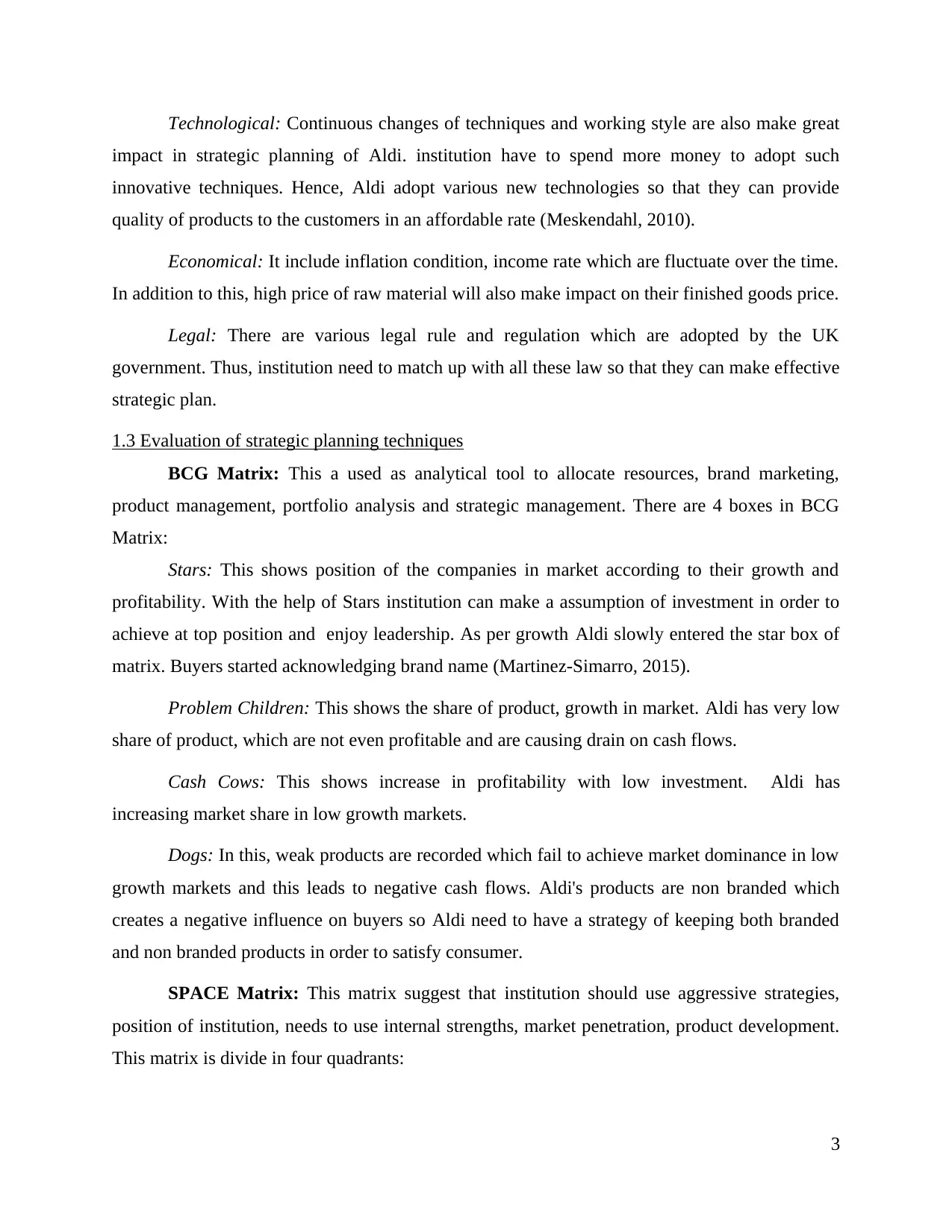
Technological: Continuous changes of techniques and working style are also make great
impact in strategic planning of Aldi. institution have to spend more money to adopt such
innovative techniques. Hence, Aldi adopt various new technologies so that they can provide
quality of products to the customers in an affordable rate (Meskendahl, 2010).
Economical: It include inflation condition, income rate which are fluctuate over the time.
In addition to this, high price of raw material will also make impact on their finished goods price.
Legal: There are various legal rule and regulation which are adopted by the UK
government. Thus, institution need to match up with all these law so that they can make effective
strategic plan.
1.3 Evaluation of strategic planning techniques
BCG Matrix: This a used as analytical tool to allocate resources, brand marketing,
product management, portfolio analysis and strategic management. There are 4 boxes in BCG
Matrix:
Stars: This shows position of the companies in market according to their growth and
profitability. With the help of Stars institution can make a assumption of investment in order to
achieve at top position and enjoy leadership. As per growth Aldi slowly entered the star box of
matrix. Buyers started acknowledging brand name (Martinez-Simarro, 2015).
Problem Children: This shows the share of product, growth in market. Aldi has very low
share of product, which are not even profitable and are causing drain on cash flows.
Cash Cows: This shows increase in profitability with low investment. Aldi has
increasing market share in low growth markets.
Dogs: In this, weak products are recorded which fail to achieve market dominance in low
growth markets and this leads to negative cash flows. Aldi's products are non branded which
creates a negative influence on buyers so Aldi need to have a strategy of keeping both branded
and non branded products in order to satisfy consumer.
SPACE Matrix: This matrix suggest that institution should use aggressive strategies,
position of institution, needs to use internal strengths, market penetration, product development.
This matrix is divide in four quadrants:
3
impact in strategic planning of Aldi. institution have to spend more money to adopt such
innovative techniques. Hence, Aldi adopt various new technologies so that they can provide
quality of products to the customers in an affordable rate (Meskendahl, 2010).
Economical: It include inflation condition, income rate which are fluctuate over the time.
In addition to this, high price of raw material will also make impact on their finished goods price.
Legal: There are various legal rule and regulation which are adopted by the UK
government. Thus, institution need to match up with all these law so that they can make effective
strategic plan.
1.3 Evaluation of strategic planning techniques
BCG Matrix: This a used as analytical tool to allocate resources, brand marketing,
product management, portfolio analysis and strategic management. There are 4 boxes in BCG
Matrix:
Stars: This shows position of the companies in market according to their growth and
profitability. With the help of Stars institution can make a assumption of investment in order to
achieve at top position and enjoy leadership. As per growth Aldi slowly entered the star box of
matrix. Buyers started acknowledging brand name (Martinez-Simarro, 2015).
Problem Children: This shows the share of product, growth in market. Aldi has very low
share of product, which are not even profitable and are causing drain on cash flows.
Cash Cows: This shows increase in profitability with low investment. Aldi has
increasing market share in low growth markets.
Dogs: In this, weak products are recorded which fail to achieve market dominance in low
growth markets and this leads to negative cash flows. Aldi's products are non branded which
creates a negative influence on buyers so Aldi need to have a strategy of keeping both branded
and non branded products in order to satisfy consumer.
SPACE Matrix: This matrix suggest that institution should use aggressive strategies,
position of institution, needs to use internal strengths, market penetration, product development.
This matrix is divide in four quadrants:
3
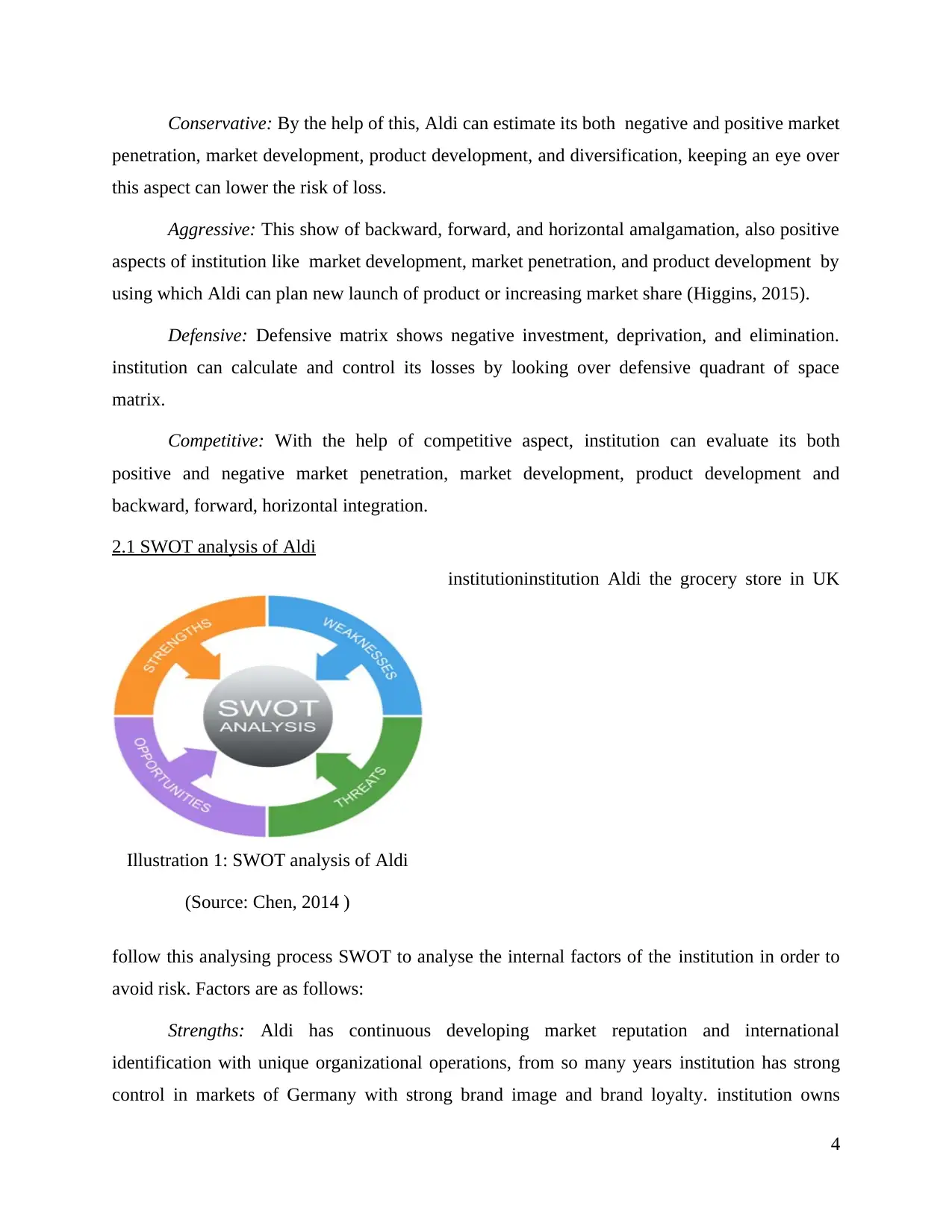
Conservative: By the help of this, Aldi can estimate its both negative and positive market
penetration, market development, product development, and diversification, keeping an eye over
this aspect can lower the risk of loss.
Aggressive: This show of backward, forward, and horizontal amalgamation, also positive
aspects of institution like market development, market penetration, and product development by
using which Aldi can plan new launch of product or increasing market share (Higgins, 2015).
Defensive: Defensive matrix shows negative investment, deprivation, and elimination.
institution can calculate and control its losses by looking over defensive quadrant of space
matrix.
Competitive: With the help of competitive aspect, institution can evaluate its both
positive and negative market penetration, market development, product development and
backward, forward, horizontal integration.
2.1 SWOT analysis of Aldi
Illustration 1: SWOT analysis of Aldi
(Source: Chen, 2014 )
institutioninstitution Aldi the grocery store in UK
follow this analysing process SWOT to analyse the internal factors of the institution in order to
avoid risk. Factors are as follows:
Strengths: Aldi has continuous developing market reputation and international
identification with unique organizational operations, from so many years institution has strong
control in markets of Germany with strong brand image and brand loyalty. institution owns
4
penetration, market development, product development, and diversification, keeping an eye over
this aspect can lower the risk of loss.
Aggressive: This show of backward, forward, and horizontal amalgamation, also positive
aspects of institution like market development, market penetration, and product development by
using which Aldi can plan new launch of product or increasing market share (Higgins, 2015).
Defensive: Defensive matrix shows negative investment, deprivation, and elimination.
institution can calculate and control its losses by looking over defensive quadrant of space
matrix.
Competitive: With the help of competitive aspect, institution can evaluate its both
positive and negative market penetration, market development, product development and
backward, forward, horizontal integration.
2.1 SWOT analysis of Aldi
Illustration 1: SWOT analysis of Aldi
(Source: Chen, 2014 )
institutioninstitution Aldi the grocery store in UK
follow this analysing process SWOT to analyse the internal factors of the institution in order to
avoid risk. Factors are as follows:
Strengths: Aldi has continuous developing market reputation and international
identification with unique organizational operations, from so many years institution has strong
control in markets of Germany with strong brand image and brand loyalty. institution owns
4
⊘ This is a preview!⊘
Do you want full access?
Subscribe today to unlock all pages.

Trusted by 1+ million students worldwide
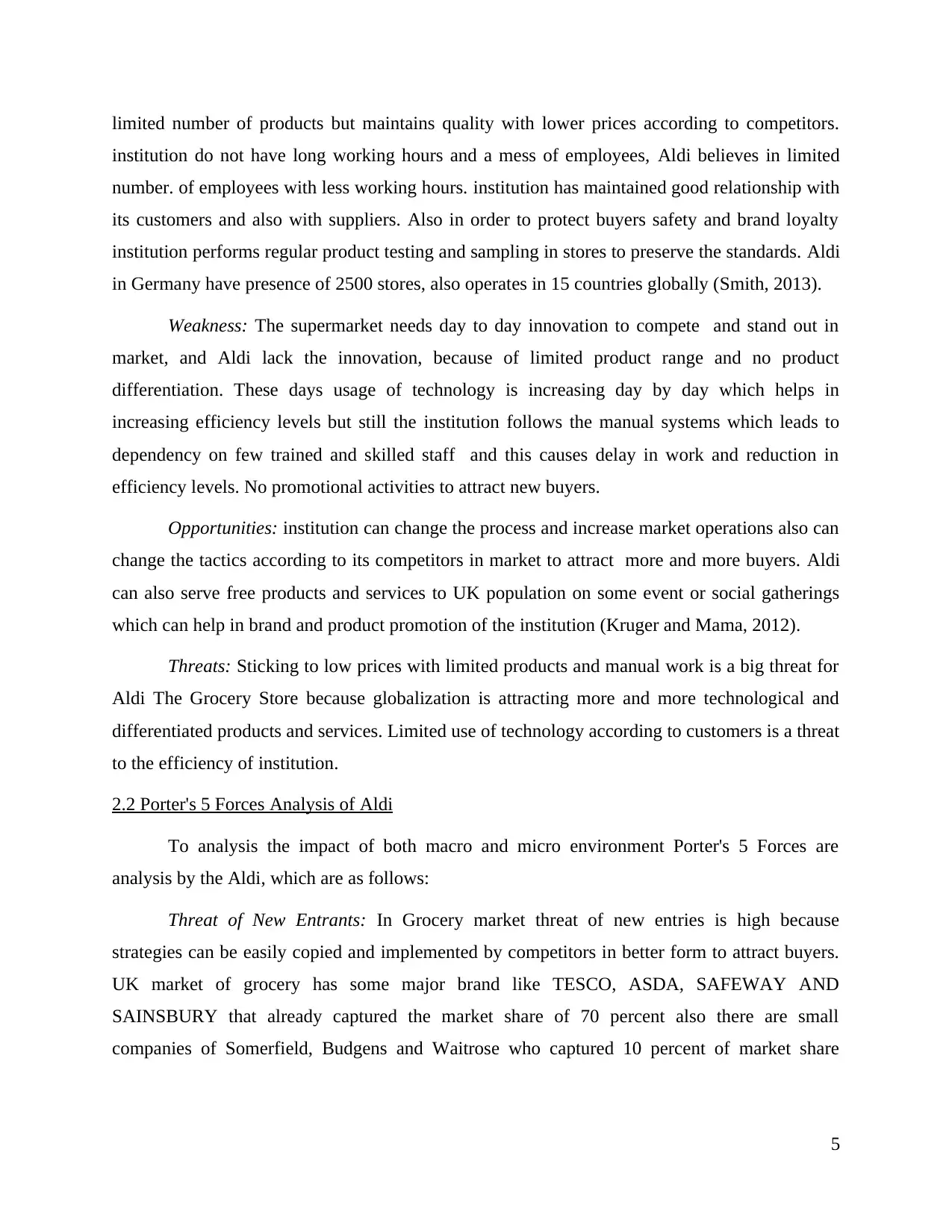
limited number of products but maintains quality with lower prices according to competitors.
institution do not have long working hours and a mess of employees, Aldi believes in limited
number. of employees with less working hours. institution has maintained good relationship with
its customers and also with suppliers. Also in order to protect buyers safety and brand loyalty
institution performs regular product testing and sampling in stores to preserve the standards. Aldi
in Germany have presence of 2500 stores, also operates in 15 countries globally (Smith, 2013).
Weakness: The supermarket needs day to day innovation to compete and stand out in
market, and Aldi lack the innovation, because of limited product range and no product
differentiation. These days usage of technology is increasing day by day which helps in
increasing efficiency levels but still the institution follows the manual systems which leads to
dependency on few trained and skilled staff and this causes delay in work and reduction in
efficiency levels. No promotional activities to attract new buyers.
Opportunities: institution can change the process and increase market operations also can
change the tactics according to its competitors in market to attract more and more buyers. Aldi
can also serve free products and services to UK population on some event or social gatherings
which can help in brand and product promotion of the institution (Kruger and Mama, 2012).
Threats: Sticking to low prices with limited products and manual work is a big threat for
Aldi The Grocery Store because globalization is attracting more and more technological and
differentiated products and services. Limited use of technology according to customers is a threat
to the efficiency of institution.
2.2 Porter's 5 Forces Analysis of Aldi
To analysis the impact of both macro and micro environment Porter's 5 Forces are
analysis by the Aldi, which are as follows:
Threat of New Entrants: In Grocery market threat of new entries is high because
strategies can be easily copied and implemented by competitors in better form to attract buyers.
UK market of grocery has some major brand like TESCO, ASDA, SAFEWAY AND
SAINSBURY that already captured the market share of 70 percent also there are small
companies of Somerfield, Budgens and Waitrose who captured 10 percent of market share
5
institution do not have long working hours and a mess of employees, Aldi believes in limited
number. of employees with less working hours. institution has maintained good relationship with
its customers and also with suppliers. Also in order to protect buyers safety and brand loyalty
institution performs regular product testing and sampling in stores to preserve the standards. Aldi
in Germany have presence of 2500 stores, also operates in 15 countries globally (Smith, 2013).
Weakness: The supermarket needs day to day innovation to compete and stand out in
market, and Aldi lack the innovation, because of limited product range and no product
differentiation. These days usage of technology is increasing day by day which helps in
increasing efficiency levels but still the institution follows the manual systems which leads to
dependency on few trained and skilled staff and this causes delay in work and reduction in
efficiency levels. No promotional activities to attract new buyers.
Opportunities: institution can change the process and increase market operations also can
change the tactics according to its competitors in market to attract more and more buyers. Aldi
can also serve free products and services to UK population on some event or social gatherings
which can help in brand and product promotion of the institution (Kruger and Mama, 2012).
Threats: Sticking to low prices with limited products and manual work is a big threat for
Aldi The Grocery Store because globalization is attracting more and more technological and
differentiated products and services. Limited use of technology according to customers is a threat
to the efficiency of institution.
2.2 Porter's 5 Forces Analysis of Aldi
To analysis the impact of both macro and micro environment Porter's 5 Forces are
analysis by the Aldi, which are as follows:
Threat of New Entrants: In Grocery market threat of new entries is high because
strategies can be easily copied and implemented by competitors in better form to attract buyers.
UK market of grocery has some major brand like TESCO, ASDA, SAFEWAY AND
SAINSBURY that already captured the market share of 70 percent also there are small
companies of Somerfield, Budgens and Waitrose who captured 10 percent of market share
5
Paraphrase This Document
Need a fresh take? Get an instant paraphrase of this document with our AI Paraphraser
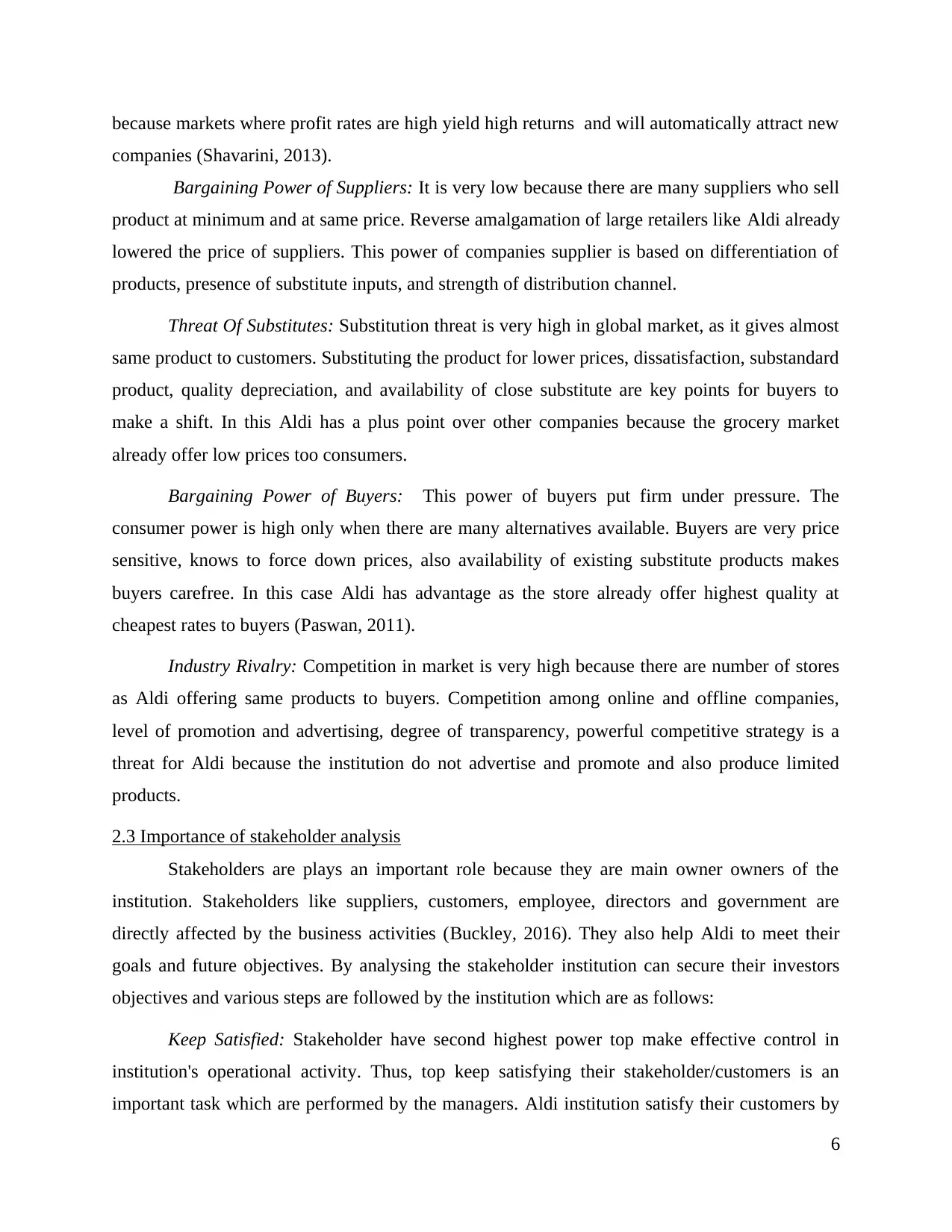
because markets where profit rates are high yield high returns and will automatically attract new
companies (Shavarini, 2013).
Bargaining Power of Suppliers: It is very low because there are many suppliers who sell
product at minimum and at same price. Reverse amalgamation of large retailers like Aldi already
lowered the price of suppliers. This power of companies supplier is based on differentiation of
products, presence of substitute inputs, and strength of distribution channel.
Threat Of Substitutes: Substitution threat is very high in global market, as it gives almost
same product to customers. Substituting the product for lower prices, dissatisfaction, substandard
product, quality depreciation, and availability of close substitute are key points for buyers to
make a shift. In this Aldi has a plus point over other companies because the grocery market
already offer low prices too consumers.
Bargaining Power of Buyers: This power of buyers put firm under pressure. The
consumer power is high only when there are many alternatives available. Buyers are very price
sensitive, knows to force down prices, also availability of existing substitute products makes
buyers carefree. In this case Aldi has advantage as the store already offer highest quality at
cheapest rates to buyers (Paswan, 2011).
Industry Rivalry: Competition in market is very high because there are number of stores
as Aldi offering same products to buyers. Competition among online and offline companies,
level of promotion and advertising, degree of transparency, powerful competitive strategy is a
threat for Aldi because the institution do not advertise and promote and also produce limited
products.
2.3 Importance of stakeholder analysis
Stakeholders are plays an important role because they are main owner owners of the
institution. Stakeholders like suppliers, customers, employee, directors and government are
directly affected by the business activities (Buckley, 2016). They also help Aldi to meet their
goals and future objectives. By analysing the stakeholder institution can secure their investors
objectives and various steps are followed by the institution which are as follows:
Keep Satisfied: Stakeholder have second highest power top make effective control in
institution's operational activity. Thus, top keep satisfying their stakeholder/customers is an
important task which are performed by the managers. Aldi institution satisfy their customers by
6
companies (Shavarini, 2013).
Bargaining Power of Suppliers: It is very low because there are many suppliers who sell
product at minimum and at same price. Reverse amalgamation of large retailers like Aldi already
lowered the price of suppliers. This power of companies supplier is based on differentiation of
products, presence of substitute inputs, and strength of distribution channel.
Threat Of Substitutes: Substitution threat is very high in global market, as it gives almost
same product to customers. Substituting the product for lower prices, dissatisfaction, substandard
product, quality depreciation, and availability of close substitute are key points for buyers to
make a shift. In this Aldi has a plus point over other companies because the grocery market
already offer low prices too consumers.
Bargaining Power of Buyers: This power of buyers put firm under pressure. The
consumer power is high only when there are many alternatives available. Buyers are very price
sensitive, knows to force down prices, also availability of existing substitute products makes
buyers carefree. In this case Aldi has advantage as the store already offer highest quality at
cheapest rates to buyers (Paswan, 2011).
Industry Rivalry: Competition in market is very high because there are number of stores
as Aldi offering same products to buyers. Competition among online and offline companies,
level of promotion and advertising, degree of transparency, powerful competitive strategy is a
threat for Aldi because the institution do not advertise and promote and also produce limited
products.
2.3 Importance of stakeholder analysis
Stakeholders are plays an important role because they are main owner owners of the
institution. Stakeholders like suppliers, customers, employee, directors and government are
directly affected by the business activities (Buckley, 2016). They also help Aldi to meet their
goals and future objectives. By analysing the stakeholder institution can secure their investors
objectives and various steps are followed by the institution which are as follows:
Keep Satisfied: Stakeholder have second highest power top make effective control in
institution's operational activity. Thus, top keep satisfying their stakeholder/customers is an
important task which are performed by the managers. Aldi institution satisfy their customers by
6
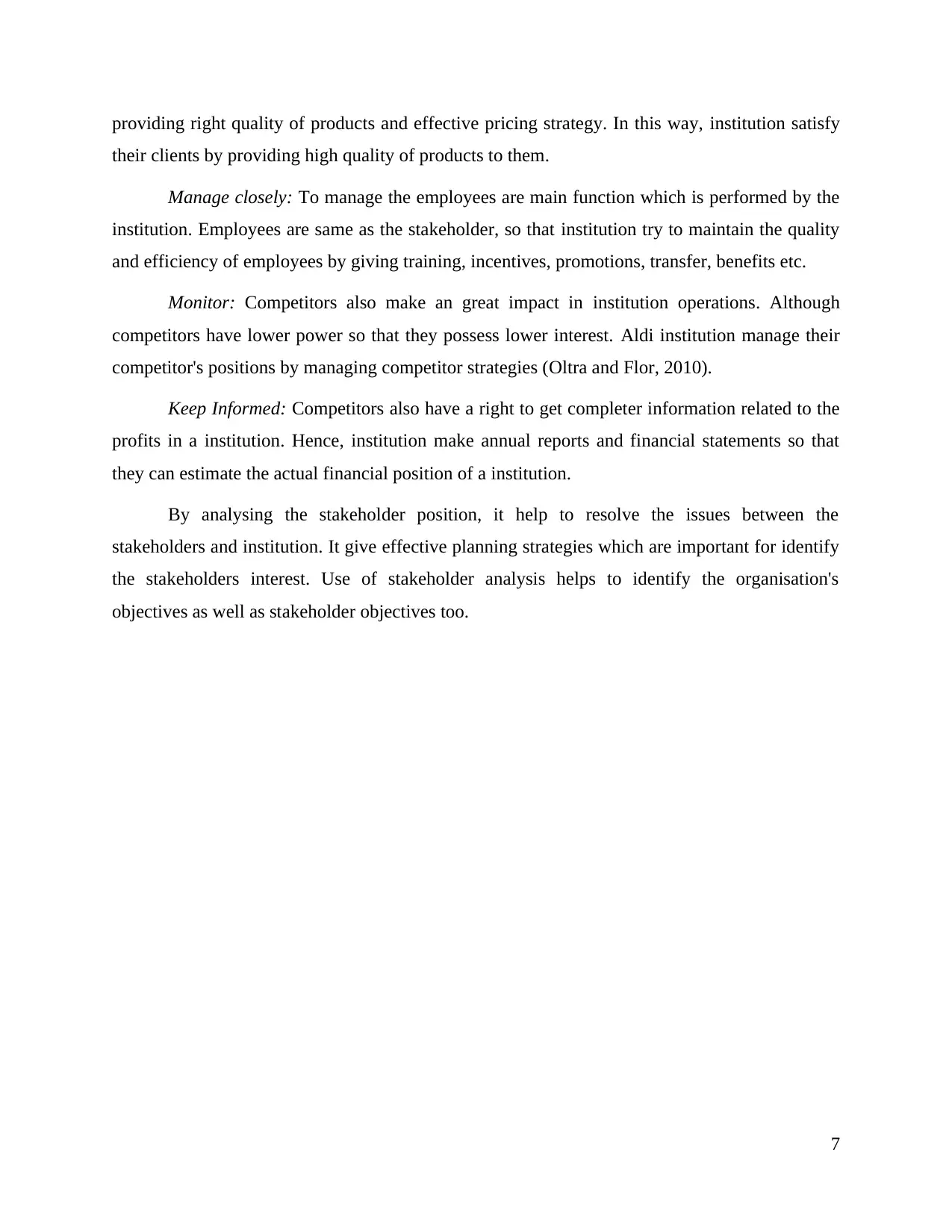
providing right quality of products and effective pricing strategy. In this way, institution satisfy
their clients by providing high quality of products to them.
Manage closely: To manage the employees are main function which is performed by the
institution. Employees are same as the stakeholder, so that institution try to maintain the quality
and efficiency of employees by giving training, incentives, promotions, transfer, benefits etc.
Monitor: Competitors also make an great impact in institution operations. Although
competitors have lower power so that they possess lower interest. Aldi institution manage their
competitor's positions by managing competitor strategies (Oltra and Flor, 2010).
Keep Informed: Competitors also have a right to get completer information related to the
profits in a institution. Hence, institution make annual reports and financial statements so that
they can estimate the actual financial position of a institution.
By analysing the stakeholder position, it help to resolve the issues between the
stakeholders and institution. It give effective planning strategies which are important for identify
the stakeholders interest. Use of stakeholder analysis helps to identify the organisation's
objectives as well as stakeholder objectives too.
7
their clients by providing high quality of products to them.
Manage closely: To manage the employees are main function which is performed by the
institution. Employees are same as the stakeholder, so that institution try to maintain the quality
and efficiency of employees by giving training, incentives, promotions, transfer, benefits etc.
Monitor: Competitors also make an great impact in institution operations. Although
competitors have lower power so that they possess lower interest. Aldi institution manage their
competitor's positions by managing competitor strategies (Oltra and Flor, 2010).
Keep Informed: Competitors also have a right to get completer information related to the
profits in a institution. Hence, institution make annual reports and financial statements so that
they can estimate the actual financial position of a institution.
By analysing the stakeholder position, it help to resolve the issues between the
stakeholders and institution. It give effective planning strategies which are important for identify
the stakeholders interest. Use of stakeholder analysis helps to identify the organisation's
objectives as well as stakeholder objectives too.
7
⊘ This is a preview!⊘
Do you want full access?
Subscribe today to unlock all pages.

Trusted by 1+ million students worldwide
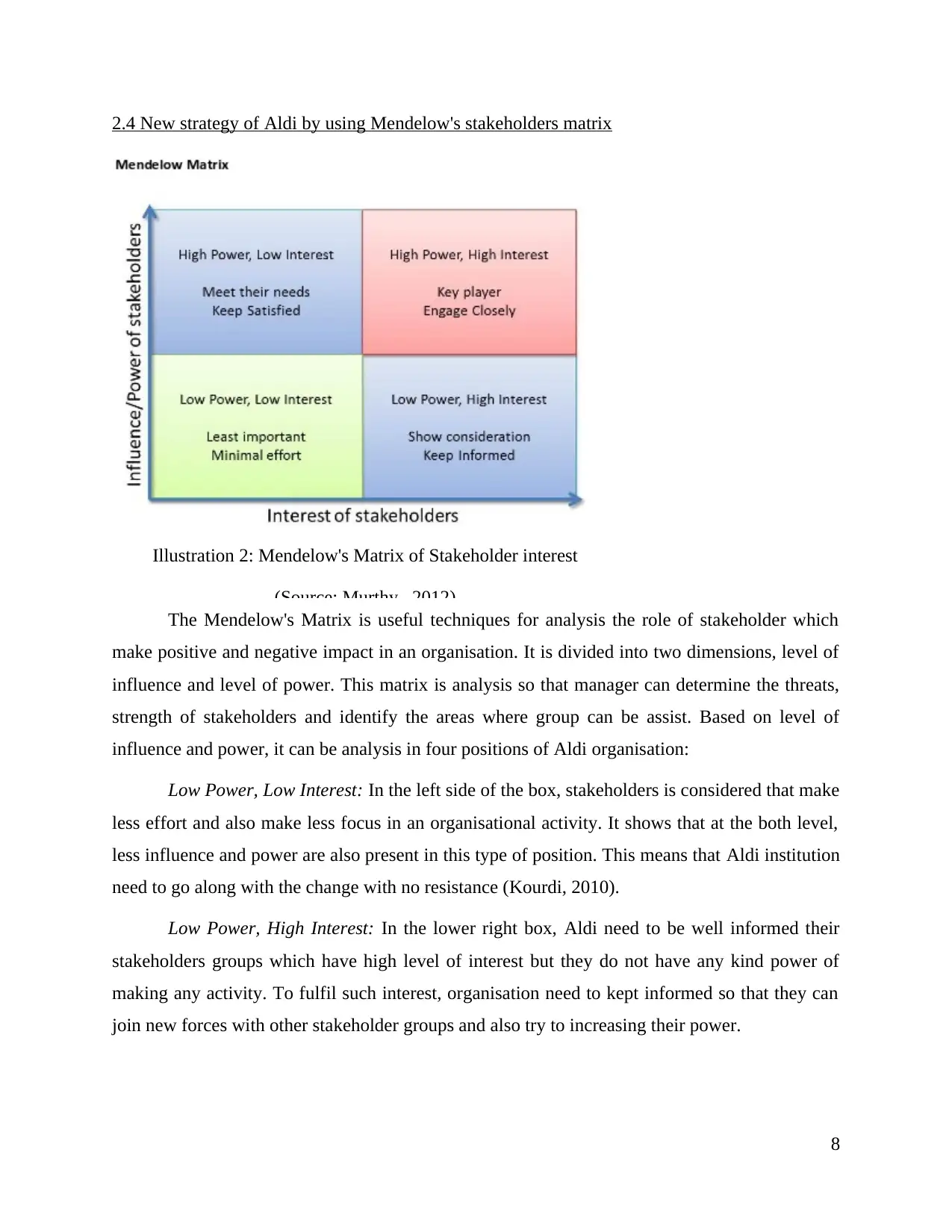
2.4 New strategy of Aldi by using Mendelow's stakeholders matrix
Illustration 2: Mendelow's Matrix of Stakeholder interest
(Source: Murthy, 2012)
The Mendelow's Matrix is useful techniques for analysis the role of stakeholder which
make positive and negative impact in an organisation. It is divided into two dimensions, level of
influence and level of power. This matrix is analysis so that manager can determine the threats,
strength of stakeholders and identify the areas where group can be assist. Based on level of
influence and power, it can be analysis in four positions of Aldi organisation:
Low Power, Low Interest: In the left side of the box, stakeholders is considered that make
less effort and also make less focus in an organisational activity. It shows that at the both level,
less influence and power are also present in this type of position. This means that Aldi institution
need to go along with the change with no resistance (Kourdi, 2010).
Low Power, High Interest: In the lower right box, Aldi need to be well informed their
stakeholders groups which have high level of interest but they do not have any kind power of
making any activity. To fulfil such interest, organisation need to kept informed so that they can
join new forces with other stakeholder groups and also try to increasing their power.
8
Illustration 2: Mendelow's Matrix of Stakeholder interest
(Source: Murthy, 2012)
The Mendelow's Matrix is useful techniques for analysis the role of stakeholder which
make positive and negative impact in an organisation. It is divided into two dimensions, level of
influence and level of power. This matrix is analysis so that manager can determine the threats,
strength of stakeholders and identify the areas where group can be assist. Based on level of
influence and power, it can be analysis in four positions of Aldi organisation:
Low Power, Low Interest: In the left side of the box, stakeholders is considered that make
less effort and also make less focus in an organisational activity. It shows that at the both level,
less influence and power are also present in this type of position. This means that Aldi institution
need to go along with the change with no resistance (Kourdi, 2010).
Low Power, High Interest: In the lower right box, Aldi need to be well informed their
stakeholders groups which have high level of interest but they do not have any kind power of
making any activity. To fulfil such interest, organisation need to kept informed so that they can
join new forces with other stakeholder groups and also try to increasing their power.
8
Paraphrase This Document
Need a fresh take? Get an instant paraphrase of this document with our AI Paraphraser
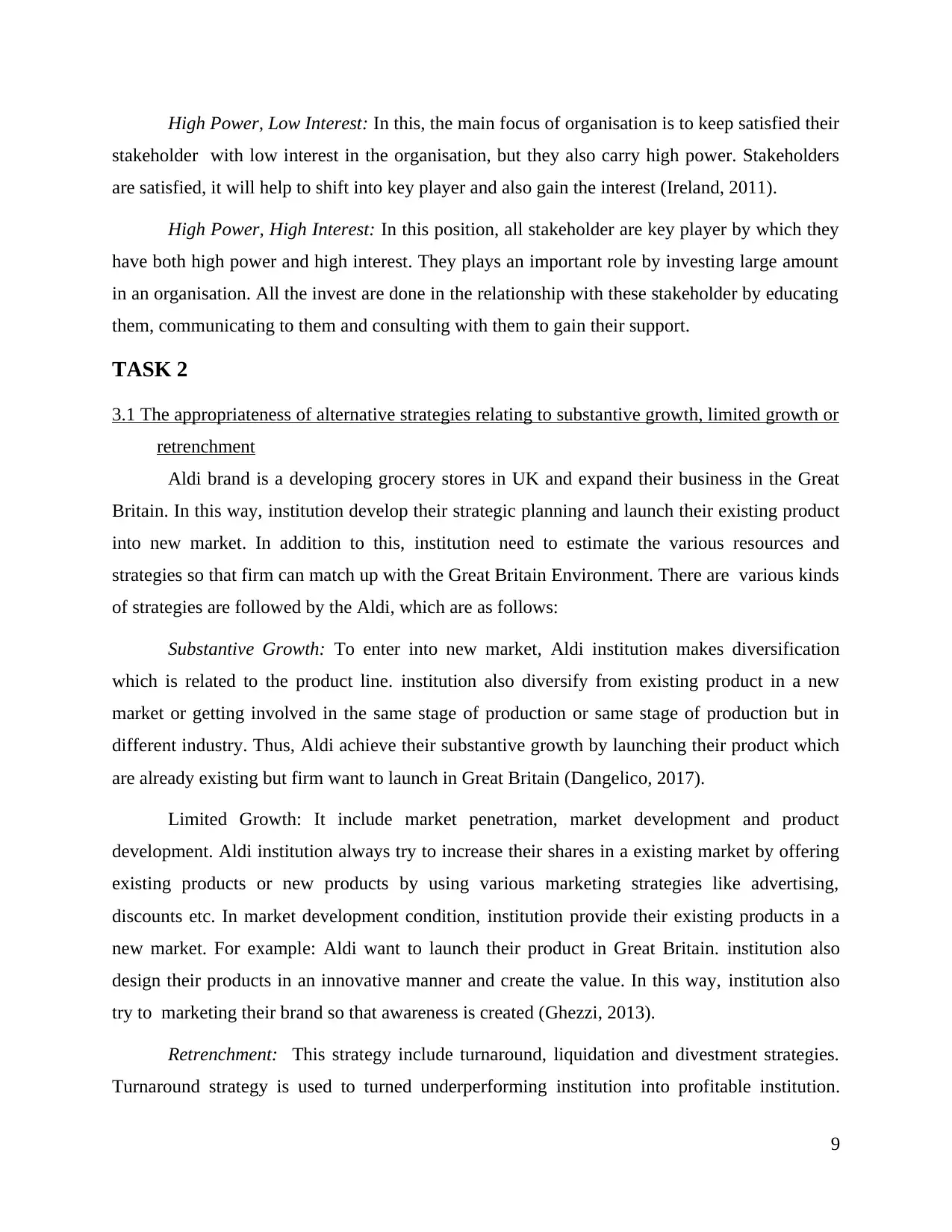
High Power, Low Interest: In this, the main focus of organisation is to keep satisfied their
stakeholder with low interest in the organisation, but they also carry high power. Stakeholders
are satisfied, it will help to shift into key player and also gain the interest (Ireland, 2011).
High Power, High Interest: In this position, all stakeholder are key player by which they
have both high power and high interest. They plays an important role by investing large amount
in an organisation. All the invest are done in the relationship with these stakeholder by educating
them, communicating to them and consulting with them to gain their support.
TASK 2
3.1 The appropriateness of alternative strategies relating to substantive growth, limited growth or
retrenchment
Aldi brand is a developing grocery stores in UK and expand their business in the Great
Britain. In this way, institution develop their strategic planning and launch their existing product
into new market. In addition to this, institution need to estimate the various resources and
strategies so that firm can match up with the Great Britain Environment. There are various kinds
of strategies are followed by the Aldi, which are as follows:
Substantive Growth: To enter into new market, Aldi institution makes diversification
which is related to the product line. institution also diversify from existing product in a new
market or getting involved in the same stage of production or same stage of production but in
different industry. Thus, Aldi achieve their substantive growth by launching their product which
are already existing but firm want to launch in Great Britain (Dangelico, 2017).
Limited Growth: It include market penetration, market development and product
development. Aldi institution always try to increase their shares in a existing market by offering
existing products or new products by using various marketing strategies like advertising,
discounts etc. In market development condition, institution provide their existing products in a
new market. For example: Aldi want to launch their product in Great Britain. institution also
design their products in an innovative manner and create the value. In this way, institution also
try to marketing their brand so that awareness is created (Ghezzi, 2013).
Retrenchment: This strategy include turnaround, liquidation and divestment strategies.
Turnaround strategy is used to turned underperforming institution into profitable institution.
9
stakeholder with low interest in the organisation, but they also carry high power. Stakeholders
are satisfied, it will help to shift into key player and also gain the interest (Ireland, 2011).
High Power, High Interest: In this position, all stakeholder are key player by which they
have both high power and high interest. They plays an important role by investing large amount
in an organisation. All the invest are done in the relationship with these stakeholder by educating
them, communicating to them and consulting with them to gain their support.
TASK 2
3.1 The appropriateness of alternative strategies relating to substantive growth, limited growth or
retrenchment
Aldi brand is a developing grocery stores in UK and expand their business in the Great
Britain. In this way, institution develop their strategic planning and launch their existing product
into new market. In addition to this, institution need to estimate the various resources and
strategies so that firm can match up with the Great Britain Environment. There are various kinds
of strategies are followed by the Aldi, which are as follows:
Substantive Growth: To enter into new market, Aldi institution makes diversification
which is related to the product line. institution also diversify from existing product in a new
market or getting involved in the same stage of production or same stage of production but in
different industry. Thus, Aldi achieve their substantive growth by launching their product which
are already existing but firm want to launch in Great Britain (Dangelico, 2017).
Limited Growth: It include market penetration, market development and product
development. Aldi institution always try to increase their shares in a existing market by offering
existing products or new products by using various marketing strategies like advertising,
discounts etc. In market development condition, institution provide their existing products in a
new market. For example: Aldi want to launch their product in Great Britain. institution also
design their products in an innovative manner and create the value. In this way, institution also
try to marketing their brand so that awareness is created (Ghezzi, 2013).
Retrenchment: This strategy include turnaround, liquidation and divestment strategies.
Turnaround strategy is used to turned underperforming institution into profitable institution.
9
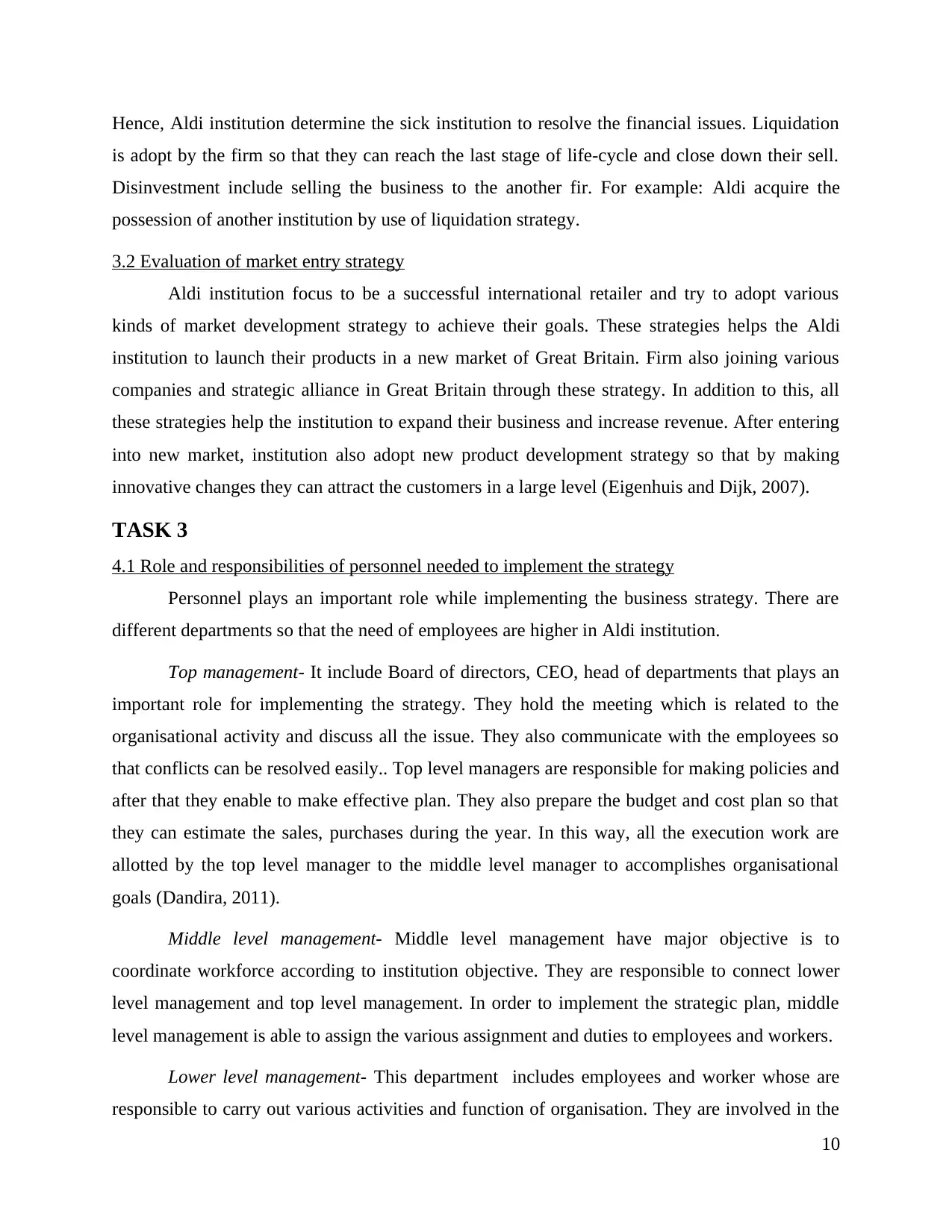
Hence, Aldi institution determine the sick institution to resolve the financial issues. Liquidation
is adopt by the firm so that they can reach the last stage of life-cycle and close down their sell.
Disinvestment include selling the business to the another fir. For example: Aldi acquire the
possession of another institution by use of liquidation strategy.
3.2 Evaluation of market entry strategy
Aldi institution focus to be a successful international retailer and try to adopt various
kinds of market development strategy to achieve their goals. These strategies helps the Aldi
institution to launch their products in a new market of Great Britain. Firm also joining various
companies and strategic alliance in Great Britain through these strategy. In addition to this, all
these strategies help the institution to expand their business and increase revenue. After entering
into new market, institution also adopt new product development strategy so that by making
innovative changes they can attract the customers in a large level (Eigenhuis and Dijk, 2007).
TASK 3
4.1 Role and responsibilities of personnel needed to implement the strategy
Personnel plays an important role while implementing the business strategy. There are
different departments so that the need of employees are higher in Aldi institution.
Top management- It include Board of directors, CEO, head of departments that plays an
important role for implementing the strategy. They hold the meeting which is related to the
organisational activity and discuss all the issue. They also communicate with the employees so
that conflicts can be resolved easily.. Top level managers are responsible for making policies and
after that they enable to make effective plan. They also prepare the budget and cost plan so that
they can estimate the sales, purchases during the year. In this way, all the execution work are
allotted by the top level manager to the middle level manager to accomplishes organisational
goals (Dandira, 2011).
Middle level management- Middle level management have major objective is to
coordinate workforce according to institution objective. They are responsible to connect lower
level management and top level management. In order to implement the strategic plan, middle
level management is able to assign the various assignment and duties to employees and workers.
Lower level management- This department includes employees and worker whose are
responsible to carry out various activities and function of organisation. They are involved in the
10
is adopt by the firm so that they can reach the last stage of life-cycle and close down their sell.
Disinvestment include selling the business to the another fir. For example: Aldi acquire the
possession of another institution by use of liquidation strategy.
3.2 Evaluation of market entry strategy
Aldi institution focus to be a successful international retailer and try to adopt various
kinds of market development strategy to achieve their goals. These strategies helps the Aldi
institution to launch their products in a new market of Great Britain. Firm also joining various
companies and strategic alliance in Great Britain through these strategy. In addition to this, all
these strategies help the institution to expand their business and increase revenue. After entering
into new market, institution also adopt new product development strategy so that by making
innovative changes they can attract the customers in a large level (Eigenhuis and Dijk, 2007).
TASK 3
4.1 Role and responsibilities of personnel needed to implement the strategy
Personnel plays an important role while implementing the business strategy. There are
different departments so that the need of employees are higher in Aldi institution.
Top management- It include Board of directors, CEO, head of departments that plays an
important role for implementing the strategy. They hold the meeting which is related to the
organisational activity and discuss all the issue. They also communicate with the employees so
that conflicts can be resolved easily.. Top level managers are responsible for making policies and
after that they enable to make effective plan. They also prepare the budget and cost plan so that
they can estimate the sales, purchases during the year. In this way, all the execution work are
allotted by the top level manager to the middle level manager to accomplishes organisational
goals (Dandira, 2011).
Middle level management- Middle level management have major objective is to
coordinate workforce according to institution objective. They are responsible to connect lower
level management and top level management. In order to implement the strategic plan, middle
level management is able to assign the various assignment and duties to employees and workers.
Lower level management- This department includes employees and worker whose are
responsible to carry out various activities and function of organisation. They are involved in the
10
⊘ This is a preview!⊘
Do you want full access?
Subscribe today to unlock all pages.

Trusted by 1+ million students worldwide
1 out of 17
Related Documents
Your All-in-One AI-Powered Toolkit for Academic Success.
+13062052269
info@desklib.com
Available 24*7 on WhatsApp / Email
![[object Object]](/_next/static/media/star-bottom.7253800d.svg)
Unlock your academic potential
Copyright © 2020–2025 A2Z Services. All Rights Reserved. Developed and managed by ZUCOL.





